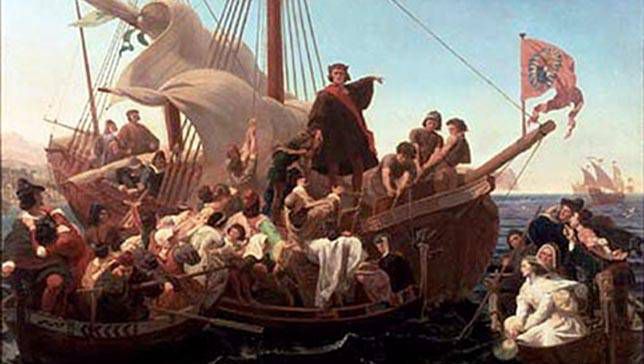Cap-Haïtien, Haiti – December 25, 1492 – On the return trip, on 24 December (1492), not having slept for two days, Columbus decided at 11:00 p.m. to lie down to sleep. The night being calm, the steersman also decided to sleep, leaving only a cabin boy to steer the ship, a practice which the admiral had always strictly forbidden. With the boy at the helm, the currents carried the ship onto a sandbank, running her aground off the present-day site of Cap-Haïtien, Haiti. It sank the next day. Realizing that the ship was beyond repair, Columbus ordered his men to strip the timbers from the ship. The timbers were later used to build a fort which Columbus called La Navidad (Christmas) because the wreck occurred on Christmas Day, north from the modern town of Limonade (see map, and the photograph).

The Santa Maria carried several anchors, possibly six. One of the anchors now rests in the Musée du Panthéon National Haïtien (MUPANAH), in Port-au-Prince, Haiti.
On 13 May 2014, underwater archaeological explorer Barry Clifford claimed that his team had found the wreck of Santa María. In the following October, UNESCO’s expert team published their final report, concluding that the wreck could not be Columbus’s vessel. Fastenings used in the hull and possible copper sheathing dated it to the 17th or 18th century.

The Santa Maria – Santa María was built in Pontevedra, Galicia, in Spain’s north-west region. Santa María was probably a medium-sized nau (carrack), about 58 ft (17.7 m) long on deck, and according to Juan Escalante de Mendoza in 1575, Santa Maria was “very little larger than 100 toneladas” (about 100 tons, or tuns) burthen, or burden, and was used as the flagship for the expedition. Santa María had a single deck and three small masts.
The other ships of the Columbus expedition were the smaller caravel-type ships Santa Clara, remembered as La Niña (“The Girl”), and La Pinta (“The Painted”). All these ships were second-hand (if not third- or more) and were not intended for exploration. Niña, Pinta, and the Santa María were modest-sized merchant vessels comparable in size to a modern cruising yacht. The exact measurements of length and width of the three ships have not survived, but good estimates of their burden capacity can be judged from contemporary anecdotes written down by one or more of Columbus’s crew members, and contemporary Spanish and Portuguese shipwrecks from the late 15th and early 16th centuries which are comparable in size to that of Santa María. These include the ballast piles and keel lengths of the Molasses Reef Wreck and Highborn Cay Wreck in the Bahamas. Both were caravel vessels 19 m (62 ft) in length overall, 12.6 m (41 ft) keel length and 5 to 5.7 m (16 to 19 ft) in width, and rated between 100 and 150 tons burden.[8] Santa María, being Columbus’ largest ship, was only about this size, and Niña and Pinta were smaller, at only 50 to 75 tons burden and perhaps 15 to 18 metres (49 to 59 ft) on deck (updated dimensional estimates are discussed below in the section entitled Replicas).
* Noteworthy
Although most Christians celebrate December 25 as the birthday of Jesus Christ, few in the first two Christian centuries claimed any knowledge of the exact day or year in which he was born. The oldest existing record of a Christmas celebration is found in a Roman almanac that tells of a Christ’s Nativity festival led by the church of Rome in 336 A.D. The precise reason why Christmas came to be celebrated on December 25 remains obscure, but most researchers believe that Christmas originated as a Christian substitute for pagan celebrations of the winter solstice.
- 800 – Pope Leo III crowns Charlemagne. Considered by some historians the “most important occurrence of the Middle Ages,” Pope Leo III and Charlemagne, King of the Franks, gave birth to the Holy Roman Empire during a Christmas mass in Rome in 800 AD. Pope Leo III bequeathed the title onto Charlemagne after intervening on Rome’s behalf to calm differences with surrounding enemies.
The coronation changed the face of Europe, establishing Rome’s independence – and protection – from the Greek Empire in Constantinople and rekindling the fallen Roman Empire under Charlemagne’s line. The empire reigned over a majority of Europe until it was dissolved in 1806.
- 1000 – The foundation of the Kingdom of Hungary: Hungary is established as a Christian kingdom by Stephen I of Hungary.
- 1776 – Washington crosses the Delaware. Following months of losses to British forces, General George Washington organized his troops to cross the partially frozen Delaware River on Christmas night to sneak up on a Hessian compound in Trenton, New Jersey. The Hessians, German mercenaries fighting for the British, were taken by surprise the next morning and were quickly overwhelmed.
- 1814 – War of 1812 ends. By terms of the treaty, all conquered territory was to be returned, and commissions were planned to settle the…
- 1868 – United States President Andrew Johnson grants an unconditional pardon to all Confederate veterans.
- 1991 – Mikhail Gorbachev resigns as President of the Soviet Union (the union itself is dissolved the next day). Ukraine’s referendum is finalized and Ukraine officially leaves the Soviet Union.
